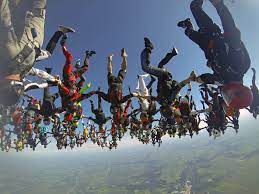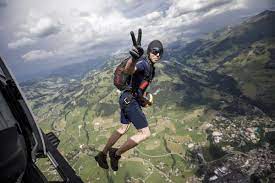Throughout history, human beings have been captivated by the allure of defying gravity and experiencing the exhilaration of freefall. Skydiving, a popular recreational activity that involves jumping from an aircraft and descending through the air with the aid of a parachute, has gained significant attention due to its inherent risks.

This article aims to provide an objective analysis of skydiving fatalities, exploring historical trends and global statistics, as well as examining factors such as age group, causes of accidents, safety measures, experience level, location, and any notable changes in fatality rates over time.
Key Takeaways of How Many People a Year Die From Skydiving
- Skydiving fatality rates have been gradually declining over the years due to advancements in safety measures and equipment, increased training, and regulation within the sport.
- Factors such as equipment malfunction, human error, weather conditions, and inadequate training contribute to skydiving fatalities.
- Evaluating the effectiveness of safety measures is crucial for reducing accidents, as safety measures vary across countries due to population size, regulations, and safety standards.
- Weather conditions significantly impact skydiving accidents, and adequate training, realistic simulations, and continuous evaluation are essential for reducing fatalities and improving safety outcomes.
Historical Skydiving Fatality Rates
The historical fatality rates of skydiving provide insight into the number of people who have died annually from this activity. Skydiving fatality statistics reveal important information about the risks associated with this extreme sport.

Over the years, there have been notable changes in the historical trends of skydiving fatalities. According to available data, there has been a gradual decline in the number of deaths related to skydiving. This can be attributed to advancements in safety measures and equipment, as well as increased training and regulation within the sport.
However, it is essential to note that even with these improvements, skydiving still carries inherent risks. Understanding the historical trends in skydiving fatality rates helps in assessing and managing these risks effectively.
Global Skydiving Fatalities
This discussion focuses on the global skydiving fatalities, including the annual death rate, factors that impact fatality rates, and the effectiveness of safety measures.
The annual skydiving death rate provides insight into the overall safety of this extreme sport and helps identify areas for improvement.
Factors such as equipment malfunction, human error, weather conditions, and inadequate training can contribute to fatalities in skydiving.
Evaluating the effectiveness of safety measures is crucial in ensuring that appropriate precautions are in place to reduce the risk of accidents and safeguard participants’ lives.
Annual Skydiving Death Rate
Approximating the annual skydiving death rate requires an examination of available data and statistical analysis. The annual skydiving death statistics provide valuable insights into the risk factors in skydiving accidents. While skydiving is generally considered a safe activity, it is not without risks. The table below presents the annual skydiving death rate for selected countries:
| Country | Annual Skydiving Deaths |
|---|---|
| United States | 21 |
| Australia | 5 |
| United Kingdom | 3 |
| Germany | 2 |
These figures highlight that there are variations in the number of fatalities across different countries. It is important to note that these statistics represent only a portion of global skydiving deaths and may be influenced by factors such as population size, regulatory frameworks, and safety standards within each country. Understanding the factors impacting fatality will provide further insight into improving safety measures in skydiving activities.
Transition Sentence: Examining the factors impacting fatality can shed light on potential areas for improvement in order to enhance overall safety in skydiving practices.
Factors Impacting Fatality
Examining the factors impacting fatality in skydiving accidents can provide valuable insights into areas that may require improvements to enhance overall safety.
Understanding the impact of weather and training on skydiving fatalities is crucial for implementing effective measures to mitigate risks.
- Impact of weather: Adverse weather conditions such as strong winds, thunderstorms, or low visibility can significantly increase the likelihood of skydiving accidents. Unfavorable weather not only affects the ability of instructors and jumpers to make safe decisions but also impairs parachute deployment and landing procedures.
- Impact of training: Adequate training plays a pivotal role in reducing fatalities in skydiving incidents. Insufficient or inadequate training can lead to poor decision-making during high-pressure situations, lack of awareness about emergency procedures, and improper execution of essential skills required for a safe jump.
- Comprehensive training programs that incorporate realistic simulations, thorough instruction on emergency protocols, and continuous evaluation can help equip skydivers with the necessary skills to navigate challenging situations effectively.
Safety Measures Effectiveness
The effectiveness of safety measures implemented in skydiving can be assessed by examining the impact they have on reducing fatalities and improving overall safety outcomes. Skydiving training plays a crucial role in ensuring the safety of participants. Proper training equips individuals with essential skills and knowledge to handle potential risks during a jump, such as emergency procedures and parachute deployment.

Moreover, consistent adherence to safety regulations and protocols further enhances safety outcomes. Weather conditions also significantly affect skydiving safety. Poor weather conditions, such as high winds or low visibility, can increase the risk of accidents and fatalities. Therefore, monitoring weather patterns and implementing appropriate restrictions or cancellations when necessary is essential for maintaining safe skydiving operations.
Transitioning into the subsequent section about ‘skydiving fatalities by age group,’ it is important to analyze these factors alongside demographic trends to gain a comprehensive understanding of skydiving’s overall safety performance.
Skydiving Fatalities by Age Group
One way to analyze skydiving fatalities is by examining the distribution of deaths across different age groups. This analysis can provide insights into the risk factors associated with skydiving and help in developing targeted safety measures.
Skydiving fatalities by age group:
- Young adults (18-34 years): This age group has been found to have the highest number of skydiving fatalities. It may be due to a combination of factors such as risk-taking behavior and physical capabilities.
- Middle-aged adults (35-54 years): While the number of fatalities decreases compared to young adults, this age group still represents a significant proportion of skydiving deaths.
- Older adults (55+ years): Skydiving fatalities among older adults are relatively lower compared to younger age groups, possibly due to fewer individuals participating in this extreme sport.
Understanding the distribution of skydiving fatalities across different age groups can assist in tailoring safety measures and educational campaigns towards those most at risk.
Common Causes of Skydiving Accidents
Skydiving accidents can occur as a result of equipment malfunctions or human error.
Equipment malfunctions may include parachute failure, harness issues, or problems with other safety gear.

On the other hand, human error can encompass mistakes made during packing the parachute, incorrect body positioning during freefall, or failure to follow safety protocols.
Understanding these common causes is crucial for improving safety measures and preventing skydiving accidents in the future.
Equipment Malfunctions
Equipment malfunctions in skydiving can pose a significant risk to the safety of individuals participating in this activity. These malfunctions can lead to serious accidents and even fatalities if not addressed promptly and effectively. Some common types of equipment malfunctions include:
1) Parachute failure: This occurs when the main parachute fails to open properly or does not deploy at all. It can be caused by issues such as line twists, improper packing, or damaged canopy.
2) Gear malfunction: This refers to problems with other essential equipment used in skydiving, such as harnesses, altimeters, or automatic activation devices (AADs). Malfunctioning gear can jeopardize the safety of the skydiver during freefall or while landing.
3) Problems with the reserve parachute: The reserve parachute is a crucial backup system that should function correctly in case of primary chute failure. However, it can also experience malfunctions like entanglement or improper deployment.
These equipment malfunctions highlight the importance of regular inspections, proper maintenance, and adherence to manufacturer guidelines for safe skydiving operations.
Human Error?
Human error plays a significant role in the occurrence of equipment malfunctions during skydiving activities. Skydiving is an inherently risky sport, and accidents can happen due to various factors, including the mistakes made by individuals involved in the process. Safety precautions are put in place to minimize the chances of human error leading to equipment malfunctions. These precautions include thorough training programs, regular equipment maintenance checks, and adherence to standard operating procedures. However, despite these measures, errors can still occur due to negligence or lack of attention. To highlight the importance of safety precautions and human error in skydiving accidents, consider the following table:
| Causes of Equipment Malfunctions | Examples |
|---|---|
| Improper gear maintenance | Frayed parachute cords |
| Inadequate pre-flight checks | Loose harness straps |
| Failure to follow protocols | Incorrect deployment |
Skydiving Safety Measures and Regulations
Implemented safety measures and regulations in the skydiving industry aim to enhance the overall security of participants. These measures include:
- Skydiving training programs: Rigorous training programs are designed to ensure that individuals have the necessary skills and knowledge to safely participate in skydiving activities. These programs cover topics such as proper body positioning, emergency procedures, and parachute deployment techniques.
- Skydiving equipment advancements: Continuous advancements in skydiving equipment have contributed significantly to improving safety. Modern parachutes are designed with enhanced stability and reliability, reducing the risk of malfunctions during jumps. Additionally, safety devices such as automatic activation devices (AADs) have been introduced to automatically deploy a reserve parachute if needed.
- Safety regulations: Regulatory bodies enforce strict guidelines for skydiving operations, including regular inspections of equipment, adherence to proper maintenance protocols, and compliance with safety standards.
By implementing these safety measures and regulations, the skydiving industry strives to minimize risks and ensure a safe experience for participants.
Transitioning into the subsequent section about ‘skydiving fatalities by experience level’, it is important to examine how these measures impact different levels of experience in terms of fatalities.
Skydiving Fatalities by Experience Level
An analysis of skydiving fatalities by experience level provides valuable insights into the impact of safety measures and regulations on different levels of expertise.
When examining skydiving fatalities by gender, it is found that there is no significant difference in the number of deaths between males and females. However, it should be noted that more males participate in skydiving activities compared to females, which could contribute to a higher number of male fatalities overall.
In terms of weather conditions, adverse weather greatly increases the risk of accidents during skydiving. Inclement weather such as strong winds, thunderstorms, or low visibility can make it difficult for skydivers to navigate safely and may lead to fatal outcomes.
Understanding these patterns can inform future safety protocols and training programs aimed at reducing the occurrence of fatal incidents in skydiving.
Moving forward, we will now explore skydiving fatalities by location.
Skydiving Fatalities by Location
When examining skydiving fatalities by location, the data reveals distinct patterns in the distribution of fatal incidents across different regions. These statistics provide valuable insights into the risks associated with skydiving and can inform safety measures and regulations in these areas.
- The United States has the highest number of skydiving fatalities each year, accounting for a significant portion of global accidents.
- Europe also experiences a notable number of skydiving fatalities, particularly in countries like France, Germany, and Switzerland where the sport is popular.
- Developing countries with growing tourism industries often see an increase in skydiving-related accidents due to factors such as inadequate training facilities or lack of stringent safety regulations.
Understanding these regional variations is crucial for improving safety standards and reducing the occurrence of skydiving accidents worldwide.
Additionally, further research should explore potential gender disparities in skydiving fatalities to identify any underlying factors that may contribute to differing risk levels for men and women.
Trends and Changes in Skydiving Fatality Rates
Trends and changes in skydiving fatality rates can be analyzed by examining the data over a specific time period, allowing for a comprehensive understanding of the factors influencing these rates.
Skydiving fatality prevention has become an important area of focus within the skydiving community. Over the years, advancements in skydiving safety have been made to reduce the risk of fatalities. These advancements include improvements in equipment design, training programs, and safety regulations.
For instance, modern parachute systems have incorporated automatic activation devices that deploy the reserve parachute if necessary. Training programs now emphasize proper jump techniques and emergency procedures. Additionally, safety regulations have been implemented to ensure adherence to standard operating procedures and maintain consistent safety standards across different skydiving centers.
Through ongoing efforts in research and development, experts continue to explore innovative ways to further enhance skydiving safety and prevent fatalities.
Frequently Asked Questions
Are There Any Specific Medical Conditions That Could Increase the Risk of a Skydiving Fatality?
Specific medical conditions can increase the risk of a skydiving fatality. These conditions may include cardiovascular diseases, respiratory disorders, neurological disorders, and musculoskeletal impairments. Proper medical screening is crucial to identify and manage such risks in potential skydivers.
How Does the Weather Affect the Number of Skydiving Fatalities?
Weather conditions can impact the number of skydiving fatalities. Adverse weather, such as high winds or storms, can increase the risk of accidents. Safety regulations exist to mitigate these risks and ensure safe skydiving operations under varying weather conditions.
Are There Any Statistics on the Number of Skydiving Fatalities Caused by Equipment Failure?
Statistics on skydiving fatalities caused by equipment failure are available. These data provide objective information about the number of deaths resulting from equipment malfunction during skydiving activities, enabling a fact-based analysis of this specific cause of fatalities in the sport.
What Is the Average Time It Takes for Someone to Become an Experienced Skydiver Before They Are Considered Less Prone to Accidents?
The average training duration for someone to become an experienced skydiver before being considered less prone to accidents varies based on individual skills and progress. Safety precautions, including thorough training and adherence to protocols, are crucial in reducing the risk of accidents.
Can You Provide Information on the Number of Skydiving Fatalities Caused by Human Error Versus Other Factors?
Common causes of skydiving fatalities include human error, equipment failure, and adverse weather conditions. Safety measures to prevent accidents include rigorous training programs, regular maintenance of equipment, and strict adherence to safety protocols.
Conclusion
In conclusion, the number of annual skydiving fatalities serves as a reminder of the inherent risks involved in this adrenaline-fueled activity. Despite safety measures and regulations implemented to minimize accidents, skydiving remains an extreme sport with potential life-threatening consequences.
The statistics on skydiving fatalities by age group, experience level, and location provide valuable insights into the patterns and trends surrounding these tragic incidents. While some may argue that such risks are justified for the thrill-seekers among us, it is undeniable that every year lives are lost in pursuit of an exhilarating experience amidst the clouds.




